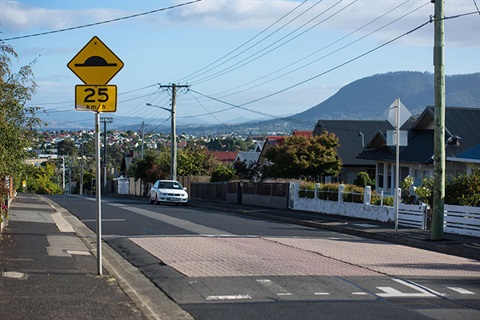Traffic calming

Traffic calming is the term given to measures used to attempt to improve the safety or use of roads, by either reducing the volume of traffic or reducing the speed of traffic on the road.
Traffic calming measures have an emphasis on residential streets, or streets with high proportions of vulnerable road users (such as school children or elderly pedestrians).
There are typically three categories of traffic calming measures:
- Education: bringing speeding issues to the community's attention. Education typically occurs on a statewide basis and comes from the Department of State Growth.
- Enforcement: the punishment of inappropriate behaviour as a deterrent. Enforcement is the responsibility of Tasmania Police.
- Engineering treatments: the making of physical alterations to the road environment to encourage drivers to change their behaviour. Engineering treatments on local roads are generally initiated by the City of Hobart.
Engineering treatments
The two types of treatments are intersection and mid-block.
Intersection treatments
Traffic calming at intersections is usually devices installed to increase the safety of an intersection. This includes things like roundabouts, traffic signals, traffic islands and banning turning movements.
The most effective way to slow down speeding vehicles is to install a roundabout, as drivers on every approach to a roundabout have to slow down enough to give way to other traffic.
Mid-block treatments
There are three classes of device that could be used in a mid-block location to reduce vehicle speeds. They are:
- vertical displacement devices (such as road humps)
- horizontal displacement devices (such as chicanes)
- road narrowing treatment (such as kerb outstands or the installation of median treatments).
Vertical displacement devices rely on discomfort to the driver caused by driving up then down so they have to reduce their speed. Road humps reduce vehicle speeds, but can also reduce on-street parking, increase vehicle noise (through heavy braking and accelerating) and increase reaction times for emergency vehicles.
A horizontal displacement device slows vehicles by forcing them to drive side to side. (These devices tend to work well on residential streets that do not have to cater for large trucks/buses.)
A treatment to narrow the width of the road can also reduce traffic speed. Roads can be narrowed by on-street parking, planting trees, linemarking and the installation of median treatments.
All the above mid-block treatments have certain advantages and disadvantages.
Generally, traffic calming measures in mid-block locations would have an emphasis on the reduction of vehicle speeds. Note that all devices are designed and installed to the approval of the State Government's Department of State Growth.
Other mid-block options
Traffic calming can also be achieved by more severe methods, including closing access to a residential street from one end (effectively turning the street into a cul-de-sac) or turning a road into a one-way street.
While these treatments can be very effective, they also can be very divisive in that they may transfer problems to other nearby streets and typically require strong justification to implement.
Issues with traffic calming
Traffic calming has the potential to provoke strong feelings in the community. In particular, treatments that restrict driver access (such as banning turning movements, making streets one way), or present an obstacle to drivers (such as road humps) can be a source of controversy.
One of the most effective and least controversial methods of traffic calming is the installation of roundabouts at intersections.
In mid-block locations, the most widely accepted calming measure is the installation of median treatments, and other treatments that reduce the available street width but such measures are not as effective nor indeed often possible in already narrow residential streets.
The City of Hobart has a limited amount of funds available for capital and maintenance works and, in terms of cost effectiveness, speed humps are the leading treatment of the speed reduction measures. The speed cushion using recycled rubber is by far the most effective treatment.